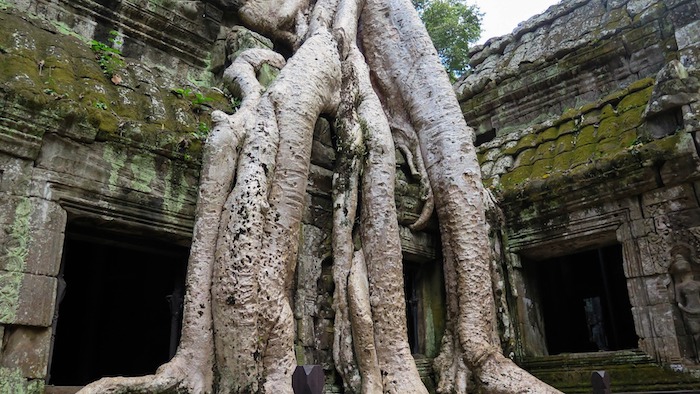Updated November 2, 2024
It might look like a movie set, but it’s real. I’m referring to a scene in the movie Tomb Raider. It’s the one where Angelina Jolie’s character Lara Croft ventures into eerie ruins among the roots of strangler figs and other huge trees. It’s actually Cambodia’s Ta Prohm: Angkor’s jewel in the heart of the Angkor Archeological Park. If you haven’t yet visited Ta Prohm, it’s definitely worth adding to your travel list.
Angkor Archeological Park
Tomb Raider aside, it’s easy to understand why Angkor is a magnet for travellers. This UNESCO World Heritage site showcases the remains of one of humankind’s most remarkable architectural achievements. More than 100 stone temples are the survivors of a grand religious, social and administrative metropolis built by the Khmer civilization between 802 and 1220. Regrettably, palaces, public buildings, houses, and anything else built of wood have long since decayed and disappeared.
The allure of Ta Prohm
Ta Prohm is unlike any other Angkor temple.
Abandoned for centuries and left to the clutches of the living jungle, Ta Prohm must have mesmerized nineteenth-century explorers when they stumbled upon it. Because many of the giant trees had, for the most part, harmoniously merged with the ancient architecture, the French colonial administration of the time decided not to proceed with a full-scale restoration of the temple.
Locked in the muscular embrace of massive trees, Ta Prohm has been preserved as an example of what the power of the jungle will do to an architectural monument once the protective hands of humans have been withdrawn.
Trunks of trees twist amongst stone pillars, and branches and leaves intertwine to form a roof over the temple. Roots coil like reptiles, spilling over the tops of temple ramparts.
In places, the tentacle-like roots of fig, banyan and silk-cotton trees have pried walls and terraces apart, devouring what was in their path. The ancient stone blocks littering the corridors of Ta Prohm are now carpeted with lichen, moss, and creeping plants.
Where architecture and nature merge, the effect is striking. This is the allure of Ta Prohm.
Ta Prohm: a once magnificent metropolis
It was interesting to learn that Ta Prohm was once a wealthy and magnificent metropolis. A Sanskrit inscription on stone provides details.
Ta Prohm comprised 3,140 villages that have long since succumbed to the ravages of time. To maintain the temple, it took 79,365 people, including 18 great priests, 2,740 officials, 2,202 assistants and 615 dancers. Among the property belonging to the temple was a set of golden dishes weighing more than 500 kilogrammes, 35 diamonds, 40,620 pearls, 4,540 precious stones, 876 veils from China, 512 silk beds, and 523 parasols.
Even considering that these numbers were probably inflated to glorify the king, Ta Prohm must have been an important and impressive monument at the time.
Tips for visiting Ta Prohm
Ta Prohm is a popular site for visitors. To avoid the tour bus crowds, visit early morning or late afternoon. Lunchtime is another window when there may be fewer visitors. At least, that was the case during my visit on a cycling tour.
Word has it that it’s at its most impressive early in the day.
Allow at least two hours to fully explore the maze-like corridors, open courtyards, delicately carved reliefs, and imposing vegetation.
Siem Reap to Ta Prohm is approximately 12 kilometres. Touring Angkor by bicycle is an attractive option. If not, booking an early morning tuk-tuk (as in 05:00) may be the way to go. Catch the sun rising over Angkor Wat, then head directly to Ta Phrom.
For more information on various tours to Angkor and things to do in Siem Reap, see the excellent resource, Siem Reap itinerary: top things to do and see.
You’ll need an Angkor Pass, available at the entrance to the park, 3 kilometres from Siem Reap. The ticket office is open from 04:30 to 17:30 daily. Tickets can be purchased online. Passes are available in one-day ($37), three-day ($62) and seven-day ($72) segments (2024 prices). Unless you’re pressed for time, pick up a three-day or seven-day pass, valid for 10 days and one month respectively. You may find yourself visiting Angkor several times to catch the sun rising and setting over Angkor Wat, and to explore the many impressive temples within the park.
For your health, safety and comfort, make a note of what to bring. In addition to these suggestions, plan what to wear when visiting Angkor Wat, the most sacred temple in the park. Our cycling group carried ‘temple pants.’ Most of us were wearing cycling shorts, and purchasing the pants at a market in Siem Reap added a layer of richness to our visit.
If you found this post helpful, please share it by selecting one or more social media buttons. Also, you might be interested in Cycling in Cambodia from Siem Reap to Sihanoukville , a description of a 300-kilometre tour that included two days’ cycling within Angkor Archeological Park. If you’re heading to Phnom Penh, take a look at Exploring Cambodia’s dark history: Tuol Sleng and Cheoung Ek.
Care to pin it?















Dear Anne – thank you so much for backlinking to my article. Have you just visited Ta Prohm or more Angkor temple as well? Your “temple pants” sound really interesting. How do they look like? Looking forward to know. By the way – first time, when I want to visit your page, I get a fatal error message. When I try twice, everything is fine.
Best 🙂 Inga
inga recently posted…Sara – one of the kind hearts in the HAVEN restaurant
I spent two days cycling in the park (plus one sunset and one sunrise by tuk-tuk). What a magnificent experience. The best part about the “temple pants” was buying them in the market in Siem Reap. They were just something long and light, out of respect when we visited Angkor Wat. Sorry about that fatal error message. There’s something putting pressure on my database, likely a plugin that needs to be deleted. Am working on it. Thanks for trying twice.
PS I read your post on HAVEN. Inspiring.
Anne Betts recently posted…Visit McSorley’s Old Ale House, New York City
Hi Anne, thank you for your answer. I will have a look on these pants, when I am back in Siem Reap again. About HAVEN – yes, also their cookbook is wonderful. Will publish an article soon. Thank you for your comment over there. Wish you a wonderful time!
Best 🙂 Inga
Hi Anne, the place really looks like a movie set! I don’t remember for how long… but I spent almost the whole day looking at those beautiful constructions! Amazing place!
Cheers,
Miguel.